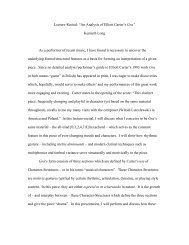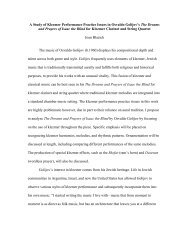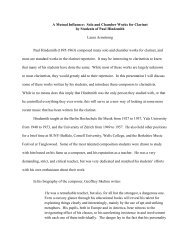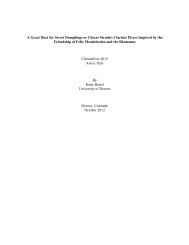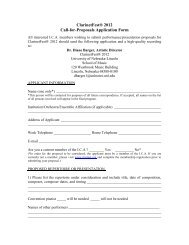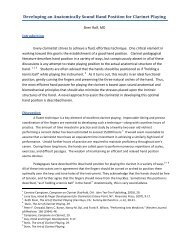Buffet Crampon's - International Clarinet Association
Buffet Crampon's - International Clarinet Association
Buffet Crampon's - International Clarinet Association
Create successful ePaper yourself
Turn your PDF publications into a flip-book with our unique Google optimized e-Paper software.
finally developed temporarily modify<br />
the curvature of the mouthpiece by 2 to<br />
5 one-hundredths of a millimetre with a<br />
degree of accuracy of plus or minus 2<br />
microns. For the material, it was a really<br />
difficult challenge. I was stacking up<br />
thin aluminum strips to arrive at the de -<br />
sired thickness but then the problem<br />
be came finding non-toxic glue. Worse,<br />
the patches were very fragile and had<br />
to be replaced frequently. Finally, in<br />
2003, an engineer named Serge Brin -<br />
golf took up the problem on my behalf.<br />
One of his suggestions was an extremely<br />
dur able plastic used in aerospace<br />
construction. Patches made of this ma -<br />
terial are not only strong, stable and<br />
very precise, but food compatible as<br />
well. They also impart a superior musical<br />
quality to the sound. This turned<br />
out to be our solution.<br />
Pierre-André Taillard, developer of Claripatch, with his invention.<br />
Q: What claims do you make for Clari -<br />
patch?<br />
A: Claripatch will enable you to get the<br />
most of your reeds as well as noticeably<br />
prolong their life expectancy, all without<br />
having to modify your mouthpiece<br />
in any way. I’m not exaggerating when<br />
I say that with Claripatch, you can ex -<br />
pect every reed you choose to play its<br />
best. During a concert you can have in -<br />
creased confidence in your instrument<br />
and your reed as Claripatch overcomes<br />
the common problems encountered due<br />
to weather conditions, changes in altitude,<br />
and changing room/hall acoustics.<br />
Simply by choosing the right patch, a<br />
good reed remains a good reed, even in<br />
the face of difficult conditions. What’s<br />
more, Claripatch can help you personalize<br />
your sound for each style of music.<br />
For example, let’s say you want to re -<br />
cre ate the sound of a period clarinet on<br />
a modern instrument. Claripatch can<br />
help you do that. The right patch or<br />
combination of patches will enable you<br />
to change the dimensions of your sound<br />
in accordance with the room or hall<br />
you are playing in: a strong and rich<br />
sound for a large hall, a soft, so phis ti -<br />
cated, colorful sound for use in cham -<br />
ber music. And you can do all this with -<br />
out having to change your reed or your<br />
way of playing.<br />
Q: Are you saying that Claripatch will<br />
make every reed you select play like a<br />
good reed?<br />
A: No, that would be impossible. The<br />
quality of the cane plays a major role,<br />
as you know. But a judicious choice of<br />
patch shifts significantly the sound<br />
quality of almost every reed. You get<br />
more concert reeds and fewer un play -<br />
able ones. In the two years of research<br />
that were necessary to bring the system<br />
to fruition, we have come up with eight<br />
profiles from among hundreds tested<br />
that address problems commonly<br />
encountered with reeds. The patches are<br />
identified with letters, such as “N”, “S,”<br />
“R” and “W.” There are patches that<br />
improve the performance of a new or an<br />
ageing reed, others for a reed that’s too<br />
hard or too soft, others for a reed that<br />
sounds too bright or too dull, another<br />
for a reed that’s waterlogged, and still<br />
another for a reed that has lost its support,<br />
particularly for detached playing<br />
or for the production of very soft sounds.<br />
We provide a chart that ex plains what<br />
each patch is designed to do. It’s a pretty<br />
good guide. Some experimentation with<br />
every reed is still necessary, though.<br />
A simple technique to save time is to<br />
write the patch recipe — NSR — on the<br />
back of the reed for future reference.<br />
With increased experience you need<br />
only a few seconds to determine the<br />
right patch.<br />
Q: How many patches come in the Clari -<br />
patch set?<br />
A: In our pro set there are 16 patches, two<br />
of each of the eight profiles. We also<br />
make a junior set that includes four<br />
patches. I should mention too that the<br />
pro set comes with what we call a clar i -<br />
mute. This simple device allows you to<br />
blow into the instrument normally but<br />
without making a sound. It’s great for<br />
practicing or warming up without disturbing<br />
anyone. And it’s an effective<br />
tool for explaining embouchure and<br />
tongu ing basics to beginners. After a<br />
few minutes, the student can easily find<br />
the optimal balance between lip and<br />
blowing pressure to maximize the airflow<br />
entering the instrument.<br />
Q: Do you recommend using more than<br />
one patch at a time?<br />
A: In our instruction booklet we say that<br />
placing two identical or two different<br />
patches on top of each other will significantly<br />
augment the effect of each patch.<br />
That’s true. It all depends on your reed,<br />
the style of music and the venue.<br />
Q: How many possible combinations are<br />
there?<br />
A: With two patches you have 45 possible<br />
combinations. With three you have 157.<br />
With all 16 patches you would have<br />
theoretically 6,561 possible combinations,<br />
but we don’t recommend using<br />
more than three patches together. If you<br />
still have problems, it is better to reconsider<br />
the choice of reed or mouthpiece.<br />
Q: How do you attach the patches to the<br />
mouthpiece?<br />
March 2006 Page 25




